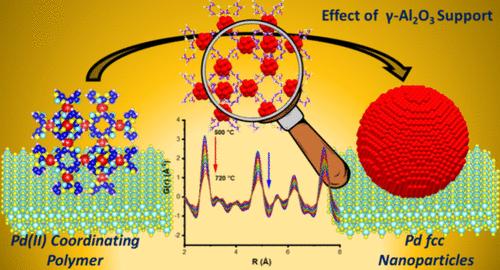当前位置:
X-MOL 学术
›
J. Phys. Chem. C
›
论文详情
Our official English website, www.x-mol.net, welcomes your feedback! (Note: you will need to create a separate account there.)
Probing the Formation and Evolution of Pd Nanoparticles on the Surface of γ-Al2O3 Using a Pd(II) Coordination Polymer as a Precursor: An In Situ X-ray Scattering and Spectroscopy Study
The Journal of Physical Chemistry C ( IF 3.3 ) Pub Date : 2024-06-26 , DOI: 10.1021/acs.jpcc.4c03277 Siddhant Singh 1 , Robert W. J. Scott 1
The Journal of Physical Chemistry C ( IF 3.3 ) Pub Date : 2024-06-26 , DOI: 10.1021/acs.jpcc.4c03277 Siddhant Singh 1 , Robert W. J. Scott 1
Affiliation

|
Due to the small size and very low metal loadings in heterogeneously supported nanoparticle catalysts, it is a characterization challenge to trace and control the formation and structural evolution of nanoparticles during their synthesis. In this report, we have probed the formation of alumina-supported Pd nanoparticles by thermal treatment of a 1:3 composite of a Pd(II) coordination polymer (Pd(II)-CP) and a γ-Al2O3 powder using in situ X-ray total scattering and X-ray absorption spectroscopy. By comparing the pyrolysis process of Pd(II)-CP in the absence and presence of γ-Al2O3, we found that the sintering of Pd nanoparticles by the coalescence of nucleation sites can be significantly reduced on γ-Al2O3 surfaces. The introduction of γ-Al2O3 provides far better control over the size, distribution, and speciation of the synthesized Pd nanoparticles. The results showed that the sintering of Pd nanoparticles does not occur on the surface of γ-Al2O3 until the Pd(II)-CP structure is fully collapsed at 400 °C, most likely because the organic framework of Pd(II)-CP provides spatially distinct sites for Pd nucleation. Moreover, the interface of the γ-Al2O3 surface and Pd(II)-CP protected the Pd nanoparticle nucleation sites from air oxidation up to 500 °C. Thereafter, a slow conversion of the Pd fcc phase to the PdO phase started taking place, which was facilitated by the formation of an amorphous PdOx phase as an intermediate.
中文翻译:

使用 Pd(II) 配位聚合物作为前驱体探讨 γ-Al2O3 表面 Pd 纳米粒子的形成和演化:原位 X 射线散射和光谱研究
由于非均相负载的纳米粒子催化剂尺寸小且金属负载量极低,因此在合成过程中追踪和控制纳米粒子的形成和结构演变是一个表征挑战。在本报告中,我们探讨了通过热处理 Pd(II) 配位聚合物 (Pd(II)-CP) 和 γ-Al 2 O 3 粉末采用原位X射线全散射和X射线吸收光谱。通过比较Pd(II)-CP在不存在和存在γ-Al 2 O 3 的情况下的热解过程,我们发现Pd纳米粒子通过成核聚结而烧结。 γ-Al 2 O 3 表面上的位点可以显着减少。 γ-Al 2 O 3 的引入可以更好地控制合成的 Pd 纳米颗粒的尺寸、分布和形态。结果表明,直到Pd(II)-CP结构在400 ℃完全塌陷后,γ-Al 2 O 3 表面才发生Pd纳米粒子的烧结。 ,很可能是因为 Pd(II)-CP 的有机框架为 Pd 成核提供了空间上不同的位点。此外,γ-Al 2 O 3 表面和 Pd(II)-CP 的界面可保护 Pd 纳米粒子成核位点在高达 500 °C 的温度下免受空气氧化。此后,Pd fcc 相开始缓慢转变为 PdO 相,作为中间体的非晶态 PdO x 相的形成促进了这一转变。
更新日期:2024-06-26
中文翻译:

使用 Pd(II) 配位聚合物作为前驱体探讨 γ-Al2O3 表面 Pd 纳米粒子的形成和演化:原位 X 射线散射和光谱研究
由于非均相负载的纳米粒子催化剂尺寸小且金属负载量极低,因此在合成过程中追踪和控制纳米粒子的形成和结构演变是一个表征挑战。在本报告中,我们探讨了通过热处理 Pd(II) 配位聚合物 (Pd(II)-CP) 和 γ-Al 2 O 3 粉末采用原位X射线全散射和X射线吸收光谱。通过比较Pd(II)-CP在不存在和存在γ-Al 2 O 3 的情况下的热解过程,我们发现Pd纳米粒子通过成核聚结而烧结。 γ-Al 2 O 3 表面上的位点可以显着减少。 γ-Al 2 O 3 的引入可以更好地控制合成的 Pd 纳米颗粒的尺寸、分布和形态。结果表明,直到Pd(II)-CP结构在400 ℃完全塌陷后,γ-Al 2 O 3 表面才发生Pd纳米粒子的烧结。 ,很可能是因为 Pd(II)-CP 的有机框架为 Pd 成核提供了空间上不同的位点。此外,γ-Al 2 O 3 表面和 Pd(II)-CP 的界面可保护 Pd 纳米粒子成核位点在高达 500 °C 的温度下免受空气氧化。此后,Pd fcc 相开始缓慢转变为 PdO 相,作为中间体的非晶态 PdO x 相的形成促进了这一转变。











































 京公网安备 11010802027423号
京公网安备 11010802027423号